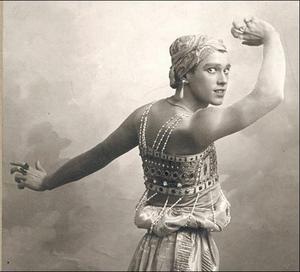

Russian dancer Vaslav Nijinsky suffered from mental illness.
In addition, A! Magazine asked living artists to talk about deceased artists who became famous despite, or because of, their mental illnesses.
DANCE
Norman Shelburne trained under the late Constance Hardinge, the founder of Bristol Ballet. Shelburne, now the artistic director of North Star Ballet in Fairbanks, Alaska, talked about Vaslav Nijinsky.
"One of the legendary figures of Russian ballet and arguably the most influential male dancer of the 20th Century, Nijinsky suffered from schizophrenia," Shelburne said. "Born in 1890 in the Russian city of Kiev, Nijinsky was the son of a Polish dancer-comedian, but was raised only by his mother who enrolled him in the Imperial Ballet School in 1898. Nijinsky was a brilliant ballet student and became the talk of St. Petersburg where critics predicted a glorious future."
"Shortly after his debut on the Imperial stage in 1907, Nijinsky met Serge Diaghilev who was developing plans to present the Russian ballet in Paris.
Diaghilev invited Nijinsky to be the premier danseur of the venture. The success of the Diaghilev Ballet Russes in Paris in 1909 was spectacular and the personal success of Nijinsky was overwhelming. Subsequent Paris seasons were even more successful with new roles designed especially for Nijinsky. In 1913, Nijinsky's marriage to a dancer in the corps de ballet terminated Nijinsky's association with Diaghilev and essentially ended his career as a dancer."
In his preface to Nijinsky's Diary, the psychoanalyst Alfred Alder traces the dancer's schizophrenia to feelings of inferiority and an escapist tendency in his personality: "Nijinsky sought the imaginary world of the stage where he became an attractive and poetic personality. In Diaghilev, Nijinsky found a mentor and source of emotional support. His marriage left him without Diaghilev's substantiation and with the many pressures of everyday life."
Shelburne noted, "Nijinsky's attempts to organize a company of his own were unsuccessful. Internment in Austria as a civilian prisoner during World War I left its mark and, after brief inconsequential tours of the United States, Nijinsky settled in Switzerland where he began to display symptoms of mental illness from which he never recovered. He died in London in 1950."
VISUAL ART
Dagmar Sproll, adjunct of the School of Arts and Sciences at King College in Bristol, Tenn., discussed several "troubled" geniuses:
• The most familiar of these is Vincent van Gogh. His emotional suffering and financial dependency on his brother are well known, as is his infamous act of self-mutilation (cutting off part of his ear lobe). His output during the last 10 years of his life was enormous, leaving about 900 paintings for posterity. The most famous of these is "Starry Night." The artist once wrote, "The only time I feel alive is when I'm painting. I want to touch people with my art. I want them to say 'he feels deeply, he feels tenderly.'"
• The great Spanish painter Francisco Goya received commissions from nobility and served as court painter to four monarchs. His early work is a joyous celebration of life but later, after going deaf, he portrayed the dark and sinister side of nightmares. He is best known for his "Executions of the Third of May, 1808," depicting the turmoil when Napoleon's forces invaded Spain. In 1819 he decorated his house with a series of frescos now called Black Paintings, which reflect his fear of insanity and his general view of mankind. The most terrifying of these is "Saturn Devouring his Children."
• Norwegian artist Edvard Munch spent the last 27 years of his life in isolation. His most famous work is "The Scream," an icon of 20th century angst (irrational fear). He was obsessed with death and wrote "without anxiety and illness, I am a ship without a rudder. They are indistinguishable from me, and their destruction would destroy my art." When he died, more than 1,000 paintings were discovered behind locked doors.
THERE'S MORE:
>> Other Famous Artists Who Suffered from Mental Illnesses